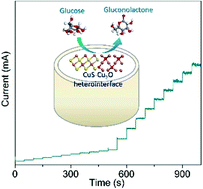Partial sulfidation for constructing Cu2O–CuS heterostructures realizing enhanced electrochemical glucose sensing†
Abstract
Numerous studies have demonstrated that the construction of heterojunctions in electrode materials resulted in a significant improvement of electrochemical glucose sensing. However, there have so far been rare studies on the underlying relationship between heterojunctions and glucose sensing, and the mechanism for enhancing the glucose sensing ability is still elusive. Herein, with the aid of experimental and theoretical studies, the Cu2O–CuS heterostructure was constructed as a proof of concept to illustrate the role that heterojunctions play in the glucose sensing process. Density functional theory (DFT) calculations revealed that Cu2O–CuS heterojunctions possessed a decreased formation energy of electroactive Cu(III) species along with a lower adsorption energy of glucose molecules, enabling more favorable reaction kinetics for glucose electrooxidation. As expected, the Cu2O–CuS electrode shows superior electrochemical glucose sensing performance with respect to the Cu2O electrode. This work provides significant implications for designing advanced electrochemical sensors in the future.



 Please wait while we load your content...
Please wait while we load your content...